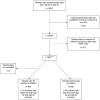The association between number and ages of children and the physical activity of mothers: Cross-sectional analyses from the Southampton Women's Survey
- PMID: 36383511
- PMCID: PMC9668156
- DOI: 10.1371/journal.pone.0276964
The association between number and ages of children and the physical activity of mothers: Cross-sectional analyses from the Southampton Women's Survey
Abstract
Background: Physical activity (PA) has many health benefits, but motherhood is often associated with reduced PA. Considering that ages and number of children may be associated with maternal PA, and that PA patterns may change as children transition to formal schooling, we aimed to investigate the associations between ages and number of children and device-measured maternal PA.
Methods: Cross-sectional analyses were conducted using data from 848 mothers from the Southampton Women's Survey at two different timepoints. Two-level random intercept linear models were used to investigate associations between ages (≤4y(ears) ("younger"), school-aged, both age groups) and number (1, 2, ≥3) of children, and their interaction, and accelerometer-assessed minutes of maternal moderate or vigorous PA (log-transformed MVPA) and light, moderate or vigorous PA (LMVPA).
Results: Women with any school-aged children engaged in more MVPA than those with only ≤4y (e.g. % difference in minutes of MVPA [95% confidence interval]: 46.9% [22.0;77.0] for mothers with only school-aged vs only ≤4y). Mothers with multiple children did less MVPA than those with 1 child (e.g. 12.5% [-1.1;24.3] less MVPA for those with 2 children). For mothers with multiple children, those with any school-aged children did less LMVPA than those with only ≤4y (e.g. amongst mothers with 2 children, those with only school-aged children did 34.0 [3.9;64.1] mins/day less LMVPA). For mothers with any ≤4y, those with more children did more LMVPA (e.g. amongst mothers with only ≤4y, those with 2 children did 42.6 [16.4;68.8] mins/day more LMVPA than those with 1 child).
Conclusions: Mothers with multiple children and only children aged ≤4y did less MVPA. Considering that many of these women also did more LMVPA than mothers with fewer or older children, interventions and policies are needed to increase their opportunities for higher intensity PA to maximise health benefits.
Trial registration: ClinicalTrials.gov Identifier: NCT04715945.
Copyright: © 2022 Simpson et al. This is an open access article distributed under the terms of the Creative Commons Attribution License, which permits unrestricted use, distribution, and reproduction in any medium, provided the original author and source are credited.
Conflict of interest statement
I have read the journal’s policy and the authors of this manuscript have the following competing interests: CC received personal fees from Alliance for Better Bone Health, Amgen, Eli Lilly, GSK, Medtronic, Novartis, Pfizer, Roche, Servier, Takeda and UCB. KMG has received reimbursement for speaking at conferences sponsored by companies selling nutritional products, and is part of an academic consortium that has received research funding from Abbott Nutrition, Nestec, BenevolentAI Bio Ltd. and Danone. NCH has received consultancy, lecture fees and honoraria from Alliance for Better Bone Health, AMGEN, MSD, Eli Lilly, Servier, UCS, Shire, Consilient Healthcare, Kyowa Kirin and Internis Pharma. The remaining authors declare they have no competing interests. This does not alter our adherence to PLOS ONE policies on sharing data and materials.
Figures



References
-
- Department of Health and Social Care. UK Chief Medical Officers’ Physical Activity Guidelines. London; 2019.
-
- World Health Organisation. Physical activity [Internet]. World Health Organisation; 2020 [accessed 05 July 2022]. https://www.who.int/news-room/fact-sheets/detail/physical-activity.
-
- Ekelund U, Steene-Johannessen J, Brown WJ, Fagerland MW, Owen N, Powell KE, et al.. Does physical activity attenuate, or even eliminate, the detrimental association of sitting time with mortality? A harmonised meta-analysis of data from more than 1 million men and women. Lancet. 2016;388(10051):1302–10. doi: 10.1016/S0140-6736(16)30370-1 - DOI - PubMed
Publication types
MeSH terms
Associated data
Grants and funding
- MC_UP_A620_1015/MRC_/Medical Research Council/United Kingdom
- NF-SI-0515-10042/DH_/Department of Health/United Kingdom
- BHF_/British Heart Foundation/United Kingdom
- MC_PC_21003/MRC_/Medical Research Council/United Kingdom
- MC_UU_12011/2/MRC_/Medical Research Council/United Kingdom
- MC_UU_00006/4/MRC_/Medical Research Council/United Kingdom
- MC_UP_A620_1014/MRC_/Medical Research Council/United Kingdom
- IS-BRC-1215-20004/DH_/Department of Health/United Kingdom
- MC_UU_00006/5/MRC_/Medical Research Council/United Kingdom
- MC_UU_12011/1/MRC_/Medical Research Council/United Kingdom
- IS-BRC-1215-20014/DH_/Department of Health/United Kingdom
- G0400491/MRC_/Medical Research Council/United Kingdom
- MC_U147585824/MRC_/Medical Research Council/United Kingdom
- CRUK_/Cancer Research UK/United Kingdom
- 107337/Z/15/Z/WT_/Wellcome Trust/United Kingdom
- MC_U147585827/MRC_/Medical Research Council/United Kingdom
- MC_PC_21000/MRC_/Medical Research Council/United Kingdom
- MC_U147585819/MRC_/Medical Research Council/United Kingdom
- MC_UU_12015/3/MRC_/Medical Research Council/United Kingdom
- MC_PC_21001/MRC_/Medical Research Council/United Kingdom
- MR/K023187/1/MRC_/Medical Research Council/United Kingdom
- MC_UU_12011/4/MRC_/Medical Research Council/United Kingdom
- MC_PC_21022/MRC_/Medical Research Council/United Kingdom
- 17/63/154/DH_/Department of Health/United Kingdom

